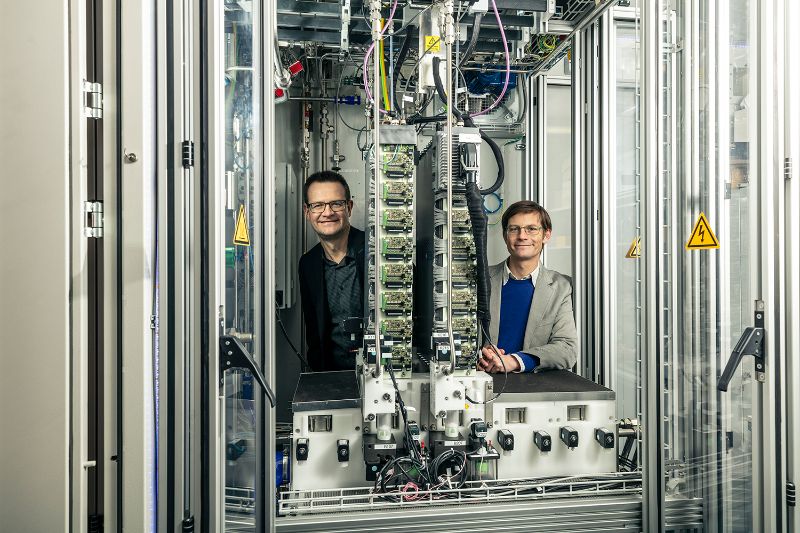“Carbon dioxide can be turned into a valuable resource”
Thomas Justus Schmidt is a chemist with a doctorate, a professor of electrochemistry at ETH Zurich and
Head of the Energy & Environment Research Division at PSI with the Energy Economics Group at the PSI’s Laboratory for Energy Systems Analysis. Industrial engineer, Tom Kober, who holds a doctorate in the field of energy economics and heads the Group, says “I have two great passions: technology and economics.” Both are working on the question: How can the Swiss energy system be decarbonised and converted to climate neutrality in accordance with the Energy Strategy 2050? Chemistry and technology are necessary for the concrete replacement of fossil energy sources and the long-term storage of electricity from renewable energy sources. Economics shows the associated costs.
The substance involved is carbon dioxide or CO2. It occurs naturally in the Earth’s atmosphere, but it is also created by the burning of wood, coal, oil or gas as well as in industrial processes. Once released, CO2 does not break down itself – it is physically stored by water bodies or broken down by green plants via photosynthesis. Since the middle of 20th century alone, global CO2 emissions have quadrupled, overwhelming the natural carbon sinks and increasing the greenhouse effect.
“Carbon dioxide can be turned into a valuable resource”: this was the surprising headline of a PSI media release in 2021. Volatile, climate-damaging carbon dioxide as a suddenly valued commodity? What sounds like witchcraft “is chemistry,” says Schmidt succinctly. CO2 is captured from the atmosphere or at the source. Just as CO2 is produced in a combustion process, “it is also possible to reverse this process, which can lead to raw materials for chemicals or synthetic fuels being created again,” explains Schmidt. Via electrolysis, a process that causes CO2 to react with water to form valuable chemicals is triggered by an electric current.
Schmidt is convinced that “the use of CO2 as a commodity can make a substantial contribution to climate protection and the energy transition.” However, the electrolysis route must be energy efficient, the electricity must come from renewable sources, and ultimately more CO2 must be retained than is released. An electrolysis cell developed at the PSI shows that even with the current Swiss electricity mix, carbon monoxide (CO), an important raw material for the production of synthetic fuels, can already be produced “which has the potential to reduce CO2 emissions,” emphasises Schmidt. Processes that function reliably in the laboratory are now on the threshold of larger scale production. There is also great potential in the production of synthetic fuel for air traffic, where decarbonisation is particularly difficult. However, thanks to the interdisciplinary research of the SynFuels initiative between PSI and Empa, they have also succeeded in producing small amounts of synthetic fuel in the laboratory.
Electricity is the key to the non-fossil energy future. In this context, storage technologies play a key role, while consumption is increasing at the same time. “Storing electricity directly over extended periods of time is extremely expensive,” explains Schmidt, adding the “path to long-term storage is via the storage of electricity in the chemical bonding of molecules, such as hydrogen, synthetic natural gas and other fuels or even methanol.” Chemicals can be used to store electricity for long periods. Production is becoming more decentralised and the plants are getting smaller. Corresponding technologies are already available on a laboratory scale. These must now be translated into viable economic business models.
Price to achieve net zero emissions
However, how much will it cost Switzerland to move to net zero emissions by 2050? Model calculations
by Kober show that additional costs of around CHF 300 per year per capita are required for this purpose. “These are the extra energy costs in addition to those we have in comparison with a reference development, in which climate protection plays a comparatively minor role,” says Kober, adding that “the costs refer to all energy system costs for mobility, buildings and industry.” This holistic approach shows how far-reaching such a transformation of Switzerland’s energy system is.
The installed capacity of photovoltaic plants, for example, must double every decade until 2050, and electricity generation from power stations and storage systems must be increased by at least one fifth, assuming that all nuclear power stations are decommissioned by 2045. The fact that every individual needs to do their part is shown, for example, by the fact that by 2030 every third new registration of a car will have an electric engine and that electric vehicles must be introduced more or less across the board by 2050. Space heat generation must also be converted from current fossil fuels to electric heat pumps on a large scale and as many potential savings as possible must be exploited.
